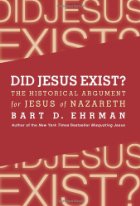*
Earl Doherty’s Response to Bart Ehrman’s Case Against Mythicism – Pt.7
Telling the Gospels Like It Is
.
COVERED IN THIS POST:
- Should “faith documents” be treated as legitimate historical sources?
- Are the Gospels independently based on oral tradition?
- Matthew and Luke’s story is Mark’s story
- Hearing about Nazareth and Jesus
- Should we trust accounts of George Washington but not Jesus?
- Equating Luke and Plutarch, or Luke and Philostratus
- Mark as sole source for a life of an earthly Jesus
- Luke and Matthew’s “special material” (“L” and “M”)
- John’s dependence on the Synoptics
- Gospels of Thomas, Peter, Egerton as “independent accounts”
.
* * * * *
.
In his Chapter 3, Bart Ehrman says that he will present “common knowledge” about the Gospels which mainstream New Testament scholars “have known for a long time.” He asks how anyone can complain about making the public more knowledgeable on these matters. Mythicists would heartily endorse that thought.
.
Gospels as Historical Sources?
(Did Jesus Exist? pp. 69-78)
.
Ehrman’s Preliminary Comment
.
Ehrman claims that
. . . once one understands more fully what the Gospels are and where they came from, they provide powerful evidence indeed that there really was a historical Jesus who lived in Roman Palestine and who was crucified under Pontius Pilate. (p. 70, DJE?)
In a “Preliminary Comment on the Gospels as Historical Sources,” Ehrman acknowledges that the Gospels “are filled with non-historical material, accounts of events that could not have happened,” that they have “many discrepancies in matters both great and small” and “contradictions all over the map.” On the other hand, there is “historical information in the Gospels,” but “it needs to be teased out by careful, critical analysis.”
To support his contention that the Gospels “can and must be considered historical sources of information,” whether by conservative congregations or by atheists/agnostics who dismiss them as faith documents with no value as history, Ehrman urges that they be recognized as literature, written by human beings in response to the human times they lived in. Such authors had no intention of producing sacred scripture. They “were simply writing down episodes that they had heard from the life of Jesus,” some of which may have been historically accurate, others not. “They had heard reports about Jesus; they had probably read earlier accounts of his life; and they decided to write their own versions.”
Ehrman inserts another reference to the intentions voiced in the Prologue of the Gospel of Luke, a topic I’ve dealt with earlier, pointing out why those statements cannot be taken at face value. Luke and the other evangelists, admits Ehrman, were not disinterested and unbiased, but
they were historical persons giving reports of things they had heard. The fact that their books later became documents of faith has no bearing on the question of whether the books can still be used for historical purposes. (p. 73, DJE?)
No bearing? Hardly. Being documents of faith — and on what grounds is Ehrman claiming they did not begin as such? — may not justify ruling them out as totally valueless, but it is a warning to use extreme care in evaluating whether anything in them is reliable history.
Does Ehrman regard the Passion in Mark’s Gospel as containing anything ‘historical’ when virtually every part of it, even at the level of individual phrases, can be shown to be dependent on — often a verbal borrowing from — a scriptural passage? (That has been recognized since around 1980.) If there is no “history remembered” (and no external corroboration not dependent on those Gospels), how do we securely perceive an actual historical event behind it? Because “Pilate” and “Caiaphas” are involved? Any fictional story can contain historical elements and characters.
Ehrman’s constant emphasis on “hearing” about what Jesus said and did as the basic channel through which the Gospel content passed is not only curious, it’s quite misleading, especially regarding the later evangelists. The old view that the Gospels are basically a recording of oral traditions circulating in Christian communities is no longer in vogue — indeed, it’s untenable. A compromise might have been that Mark was dependent largely on oral tradition, but that the later evangelists essentially redacted Mark (with the exception of John’s ministry), with Matthew and Luke inserting the contents of a written collection of sayings into that redaction. Continue reading “7. Earl Doherty’s Response to Bart Ehrman’s Case Against Mythicism: Telling the Gospels Like It Is”




